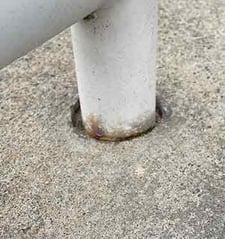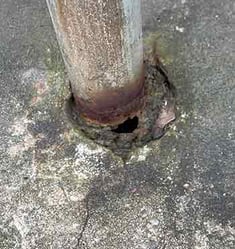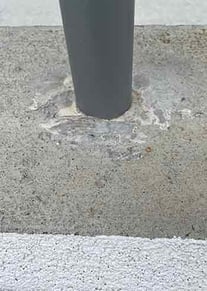Cementitious Expansion Grout
On any construction project, grout can be found everywhere. Mounting Handrails, Setting Anchor Bolts, Under Base Plates, etc. The important thing to consider when using grout is exposure to the elements.
Typical construction uses a “controlled expansion” grout, i.e. – as it sets it expands slowly to create pressure. This can be achieved with a Portland Cement based grout, or gypsum based. The difference is the Portland cement type will expand and remain at its expanded pressure indefinitely in both interior and exterior environments.
 Gypsum based grouts will behave similarly only in interior applications. When exposed to the elements and temperature fluctuations after 12 to 18 months they begin to contract. At this point the contraction is minimal enough to not affect performance. (Fig. 1) However limited the space created, in an exterior application water will find its way into the gaps.
Gypsum based grouts will behave similarly only in interior applications. When exposed to the elements and temperature fluctuations after 12 to 18 months they begin to contract. At this point the contraction is minimal enough to not affect performance. (Fig. 1) However limited the space created, in an exterior application water will find its way into the gaps.
Fig. 1 The grout has begun to decay leaving
an unwanted cavity that will continue to
collect water.
 This can be corrosive enough but the real problem occurs if water is present and the temperature drops below freezing. Water will shrink as it cools, like almost everything else, until it reaches 39°F (4° C). It then expands very slightly as it continues to cool from 39°F to the freezing point, 32°F. Once the water temperature drops below 32°F it freezes and expands 9%. In any concrete application this will cause the water-filled area to expand. As the freeze / thaw cycle is repeated the continued expansion will eventually crack the grout. This allows additional water to fill the crevasses. When that freezes again, greater pressure is exerted on the grout and surrounding concrete, eventually leading to decay.
This can be corrosive enough but the real problem occurs if water is present and the temperature drops below freezing. Water will shrink as it cools, like almost everything else, until it reaches 39°F (4° C). It then expands very slightly as it continues to cool from 39°F to the freezing point, 32°F. Once the water temperature drops below 32°F it freezes and expands 9%. In any concrete application this will cause the water-filled area to expand. As the freeze / thaw cycle is repeated the continued expansion will eventually crack the grout. This allows additional water to fill the crevasses. When that freezes again, greater pressure is exerted on the grout and surrounding concrete, eventually leading to decay.
Fig. 2 Shows the grout severely compromised
and the surrounding concrete cracked also.
Portland Cement based grout will also display a controlled expansion and develop up to 7,500 psi. of compressive strength. However once curing and expansion is complete, it will not shrink in exterior or interior applications. This avoids the cracking, shrinking, gaps, water intrusion and freezing that occurs with gypsum grouts.
compressive strength. However once curing and expansion is complete, it will not shrink in exterior or interior applications. This avoids the cracking, shrinking, gaps, water intrusion and freezing that occurs with gypsum grouts.
The setting shown in Fig. 3 is now 10 years old and exists in an exterior application. Temperatures at this location regularly go below 20°F during the winter so freezing would create problems. Due to proper mixing and curing conditions no compromise is visible and it is likely the grout will remain intact for the life of the concrete.
Note: While it is not easily visible in this photo, the grout is gently domed to move water away from the base of the handrail.
Fig. 3 Properly mixed and cured Cement Based Non-Shrink Grout




